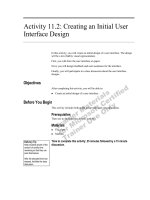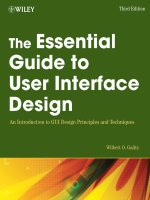User interface design
Bạn đang xem bản rút gọn của tài liệu. Xem và tải ngay bản đầy đủ của tài liệu tại đây (134.92 KB, 17 trang )
©Ian Sommerville 2004 Software Engineering, 7th edition. Chapter 16 Slide 1
User interface design
©Ian Sommerville 2004 Software Engineering, 7th edition. Chapter 16 Slide 2
Objectives
To suggest some general design principles for user
interface design
To explain different interaction styles and their use
To explain when to use graphical and textual
information presentation
To explain the principal activities in the user
interface design process
To introduce usability attributes and approaches to
system evaluation
©Ian Sommerville 2004 Software Engineering, 7th edition. Chapter 16 Slide 3
Topics covered
Design issues
The user interface design process
User analysis
User interface prototyping
Interface evaluation
©Ian Sommerville 2004 Software Engineering, 7th edition. Chapter 16 Slide 4
The user interface
User interfaces should be designed to match
the skills, experience and expectations of its
anticipated users.
System users often judge a system by its
interface rather than its functionality.
A poorly designed interface can cause a user
to make catastrophic errors.
Poor user interface design is the reason why
so many software systems are never used.
©Ian Sommerville 2004 Software Engineering, 7th edition. Chapter 16 Slide 5
Human factors in interface design
Limited short-term memory
• People can instantaneously remember about 7 items of
information. If you present more than this, they are more
liable to make mistakes.
People make mistakes
• When people make mistakes and systems go wrong,
inappropriate alarms and messages can increase stress
and hence the likelihood of more mistakes.
People are different
• People have a wide range of physical capabilities.
Designers should not just design for their own capabilities.
People have different interaction preferences
• Some like pictures, some like text.
©Ian Sommerville 2004 Software Engineering, 7th edition. Chapter 16 Slide 6
UI design principles
UI design must take account of the needs,
experience and capabilities of the system
users.
Designers should be aware of people’s
physical and mental limitations (e.g. limited
short-term memory) and should recognise
that people make mistakes.
UI design principles underlie interface
designs although not all principles are
applicable to all designs.
©Ian Sommerville 2004 Software Engineering, 7th edition. Chapter 16 Slide 7
User interface design principles
Principle Description
User familiarity The interface should use terms and concepts which are drawn
from the experience of the people who will make most use of the
system.
Consistency The interface should be consistent in that, wherever possible,
comparable operations should be activated in the same way.
Minimal surprise Users should never be surprised by the behaviour of a system.
Recoverability The interface should include mechanisms to allow users to
recover from errors.
User guidance The interface should provide meaningful feedback when errors
occur and provide context-sensitive user help f acilities.
User diversity The interface should provide appropriate interaction facilities for
different types of system user.
©Ian Sommerville 2004 Software Engineering, 7th edition. Chapter 16 Slide 8
Design principles
User familiarity
• The interface should be based on user-oriented
terms and concepts rather than computer concepts. For
example, an office system should use concepts such as
letters, documents, folders etc. rather than directories, file
identifiers, etc.
Consistency
• The system should display an appropriate level
of consistency. Commands and menus should have the
same format, command punctuation should be similar,
etc.
Minimal surprise
• If a command operates in a known way, the user should
be
able to predict the operation of comparable commands
©Ian Sommerville 2004 Software Engineering, 7th edition. Chapter 16 Slide 9
Design principles
Recoverability
• The system should provide some resilience to
user errors and allow the user to recover from errors. This
might include an undo facility, confirmation of destructive
actions, 'soft' deletes, etc.
User guidance
• Some user guidance such as help systems, on-line
manuals, etc. should be supplied
User diversity
• Interaction facilities for different types of user should be
supported. For example, some users have seeing
difficulties and so larger text should be available
©Ian Sommerville 2004 Software Engineering, 7th edition. Chapter 16 Slide 10
Design issues in UIs
Two problems must be addressed in interactive
systems design
• How should information from the user be provided to the
computer system?
• How should information from the computer system be
presented to the user?
User interaction and information presentation may
be integrated through a coherent framework such as
a user interface metaphor.
©Ian Sommerville 2004 Software Engineering, 7th edition. Chapter 16 Slide 11
Interaction styles
Direct manipulation
Menu selection
Form fill-in
Command language
Natural language
©Ian Sommerville 2004 Software Engineering, 7th edition. Chapter 16 Slide 12
Interaction styles
Interaction
style
Main advantages Main disadvantages Application
examples
Direct
manipulation
Fast and intuitive
interaction
Easy to learn
May be hard to implement.
Only suitable where there is a
visual metaphor for tasks and
objects.
Video games
CAD systems
Menu
selection
Avoids user error
Little typing required
Slow for experienced users.
Can become complex if many
menu options.
Most general-
purpose systems
Form fill-in Simple data entry
Easy to learn
Checkable
Takes up a lot of screen space.
Causes problems where user
options do not match the form
fields.
Stock control,
Personal loan
processing
Command
language
Powerful and flexible Hard to learn.
Poor error management.
Operating systems,
Command and
control systems
Natural
language
Accessible to casual
users
Easily extended
Requires more typing.
Natural language understanding
systems are unreliable.
Information
retrieval systems
©Ian Sommerville 2004 Software Engineering, 7th edition. Chapter 16 Slide 13
Multiple user interfaces
Linux operating system
X-windows GU I
mana ger
Graphical user
inter face
(Gnome/KDE)
Command
langua ge
interpreter
Unix shell
inter face
(ksh/csh)
©Ian Sommerville 2004 Software Engineering, 7th edition. Chapter 16 Slide 14
LIBSYS interaction
Document search
• Users need to be able to use the search
facilities to find the documents that they need.
Document request
• Users request that a document be delivered to
their machine or to a server for printing.
©Ian Sommerville 2004 Software Engineering, 7th edition. Chapter 16 Slide 15
Web-based interfaces
Many web-based systems have interfaces
based on web forms.
Form field can be menus, free text input,
radio buttons, etc.
In the LIBSYS example, users make a
choice of where to search from a menu and
type the search phrase into a free text field.
©Ian Sommerville 2004 Software Engineering, 7th edition. Chapter 16 Slide 16
LIBSYS search form
LIBSYS: Search
Choose collection
Keyword or phrase
Search using
Adjacent words
Search Reset Cancel
All
Title
Yes No
©Ian Sommerville 2004 Software Engineering, 7th edition. Chapter 16 Slide 17
Information presentation
Information presentation is concerned with
presenting system information to system
users.
The information may be presented directly
(e.g. text in a word processor) or may be
transformed in some way for presentation
(e.g. in some graphical form).
The Model-View-Controller approach is a
way of supporting multiple presentations of
data.
©Ian Sommerville 2004 Software Engineering, 7th edition. Chapter 16 Slide 18
Information presentation
Information to
be displa yed
Presenta tion
softw are
Display









